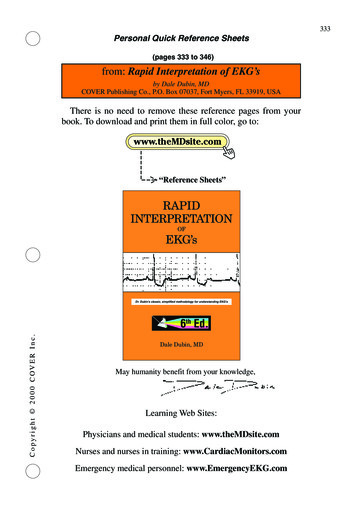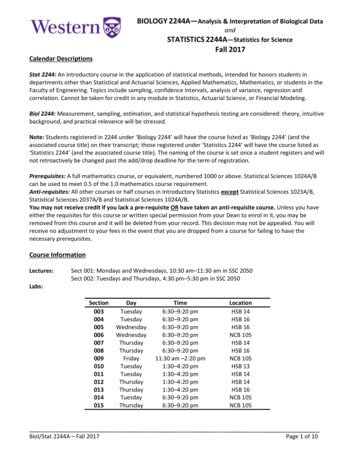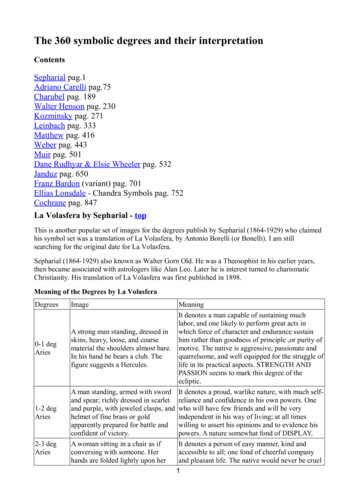
Transcription
EKGPage 1 of 26Basics of EKG Interpretation: A Programmed StudyAcknowledgement is given to Leslie K. Muma, MS, RN, NP for assistance in prepartion of this learning module.Description – The course is designed as an elective to give the advanced practice nurse, involved in the care of patients withcardiopulmonary problems, a basic introduction to the principles of EKG interpretation. The course is in a self-programmedformat whereby the student reviews EKGs with accompanying case histories and answers. The EKGs selected representcommonly occurring cardiopulmonary problems in the primary care setting and provide additional means by which nursescan correlate their knowledge of pathophysiology and cardiopulmonary physical assessment (theory and skills) with findingsdemonstrable on a EKG.Objectives:Identify structures demonstrable on EKG.Recognize a normal EKG.Recognize and name the EKG signs of asystole, atrial fibrillation, atrial flutter, bradycardia,premature atrial contractions, premature ventricular contractions, ventricular fibrillation, angina,myocardial infarction, CHF, and COPD seen with cardiopulmonary disease.Correlate physical signs and symptoms of cardiopulmonary disease with EKG findings.Prerequisites:Graduate standing.Consent of instructor.Course Requirements:Pre-test and Post-test of EKG interpretation administered by instructor.GradingChoice of letter grade or satisfactory/unsatisfactory. A satisfactory grade is obtained by achieving80% or greater on the post-test. The post-test may be retaken as many times as necessary in order toachieve a passing grade.Required Web Sites:Basics of EKG Interpretation: A Programmed ded Texts:Dubin, D. (1996). Rapid Interpretation of EKG’s. Tampa Florida: Cover Publishing Co.Evans, T. (1996). ECG Interpretation Cribsheets. 3rd ed. San Francisco, CA: Ring Mountain Press.Recommended Web u/fac-staff/ritter/ekg.htm9/27/04
EKGPage 2 of 26Recommended Schedule for EKG Practicum:This schedule is given to be used as a guideline to the practicum. The order of the EKGs has been selected to build and reinforce prior learning. The material to beread may not follow exactly, but may be utilized as a reference. Basics of EKG Interpretation: A Programmed Study (BEI) is a self-learning module which you mayuse at your own pace.EKGsBEI1. EKG BasicsSection 12. MISection 13. Disease, Drug, ElectrolyteSection 1Abnormalities4. Axis, EKG interpretationSection 25. Heart Blocks, AtrialArrythmiasSection 36. Ventricular ArrythmiasSection 47. PacemakersSection 48. Appendices: Evaluation,Procedures, Medications,ComplicationsSection 4EKGS: SECTION ONEPART I: THE BASICSELECTRODE PLACEMENT FOR 12-LEAD ECGsLimb Leads (I, II, II, aVR, aVL, aVF) are obtained from electrodes labeled as LA or left arm, RA or right arm, LL or left leg, and RL or right leg, which arepositioned either on the distal (wrists and ankles) or proximal extremities (shoulders and groins). Left leg electrodes must be placed below the heart (but not on thechest), preferably below the umbilicus, to get an accurate lead II, II, and aVF. The six limb leads are used to determine frontal plane axis. The sensing electrode foreach lead "looks back" at the heart from its positive or sensing electrode. Thus leads II, III, and aVF "look" at the inferior surface of the heart; leads I and aVL "look"at the left or lateral side of the heart; and aVR "looks" at the right side of the m9/27/04
EKGPage 3 of 26Limb leads are usually labeled but also occasionally color coded so that:Right arm — "White is on the right."Right leg — "Green is for go." (Right leg is gas pedal.)Left leg — "Red is for stop." (Some brake with left leg.)Left arm — black lead.Unipolar Leads (all have "V" in their names) — aVR, aVL, aVF, and the precordial leads V1-V6.Require more electrodes on the patient (a minimum of 4-5).All have an "exploring" electrode which "looks" directly at the heart from its site of placement.All also require three "indifferent" electrodes (RA, LA, and LL) but which do not contribute toward the tracing.PRECORDIAL PLACEMENT OF UNIPOLAR ELECTRODES FOR 12 LEAD ECGsAll precordial leads bisect at AV node [point toward the AV node in a horizontal tm9/27/04
EKGPage 4 of 26Right chest (or anterior) leads — V1, V2; also aVR.Septal leads — V3 and V4 — located over the interventricular septum.Left chest (or lateral) leads — V5, V6; also I and aVL.V1 and V2 mirror changes occurring from the posterior side of the heart. None of the usual electrodes are directly adjacent to the posterior surface of the heart.If additional posterior leads need to be seen, (e.g., to diagnose a true posterior infarction) do another 12 lead ECG but move 3 electrodes to these positions:V7 same horizontal plane as V4-V6; PAL (posterior axillary line).V8 same horizontal plane as V4-V6; mid-scapula.V9 same horizontal plane as V4-V6; over spine.If additional right chest leads need to be seen, (e.g., to diagnose a right ventricular infarction) do another 12 lead ECG but move 4 electrodes to these g.htm9/27/04
EKGPage 5 of 26V3R halfway between V1 and V4R.V4R 5 RICS at MCL.V5R same horizontal plane as V4R at AAL (anterior axillary line).V6R same horizontal plane as V4R at MAL (mid-axillary line).PLACEMENT OF BIPOLAR LEADS (I, II, III, MCL1, MCL6) FOR MONITORINGRA right arm LA left armRL right leg LL left legLead I — LA is , RA is -, RL is ground.Lead II — LL is , RA is -, RL is ground.Lead III — LL is , LA is -, RL is ground.* NOTE: LL electrode should always be placed below the umbilicus in order to avoid problems in patients with ventricular hypertrophy.* NOTE: In placing electrodes on the chest, always find the angle of Louis (palpable junction of the manubrium and body of the sternum). Slide to the side and youare on the second rib with the 2nd intercostal space just below it. Count down to the correct interspace from there.Bipolar leads look from a positive pole toward a negative pole. The positive electrode "looks" directly at the heart from the site where it is placed. Ground electrodesdo not contribute to the tracing. "Quick look" defibrillator paddles are also bipolar.Lead MCL1 — use lead I selection on monitor; positive electrode placed in 4ICS (4th intercostal space) at the RSB (right sternal border); negative electrode placedon L shoulder; ground may be placed anywhere.V1 is the single best lead for diagnosing dysrhythmias; MCL1 is a substitute for V1 which can be recorded from 3 lead-wire patient cables.MCL1 is very similar to, but not identical to, pattern seen in V1 precordial lead.Rhythms which can be distinguished in V1 or MCL1 but not in other leads include those with a widened QRS complex such as right versus left ventricular htm9/27/04
EKGPage 6 of 26right and left bundle branch blocks, and differentiation of supraventricular rhythms with aberration from ventricular rhythms. Also, Pwaves are often visible in V1 and MCL1 when they are invisible in other leads because the exploring electrodes is the one closest to the atria.Lead MCL6 — almost the same electrode placement as MCL1, but the positive electrode is placed in the 5ICS in the left MAL (mid-axillary line). MCL6 is verysimilar to, but not identical to, pattern seen in V6 precordial lead.ECG PAPER — standardized so we can compare patients.Time is measured from the L to the R — one large box 0.20 sec and one small one 0.04 sec.The rate of the ECG machine is 25 mm/sec. Marks on the upper or lower border of paper fall every 3 sec or 3 inches.Voltage or current strength is determined from the magnitude or height of the various waveforms and is measured in mV or mm — one small box normally 0.1 mVor 1 mm and one large box 0.5 mV or 5 mm.Voltage strength can be adjusted when recording the ECG. Thus if the waveform is especially large, as in the precordial leads of a patient with ventricularhypertrophy, or especially small, as in a patient with severe lung disease, the size of the waveforms can be adjusted to fit the paper. Acalibration mark is thus made at the beginning of the recording to denote whether it is at full-, half-, or, occasionally, double-amplitude. The normal calibration markshould be a full 10 mm for a 0.1 mV calibration. At half-amplitude each vertical block equals 0.2 mV ; at double-amplitude each vertical block equals 0.05 mV.Full Amplitude Half Amplitude Double AmplitudeIf an electrical impulse is moving toward the sensing electrode a positive (upright) deflection is recorded; if the impulse is moving away from the sensing electrode, anegative (downward) deflection is recorded; when an impulse travels perpendicular to (90 away from) the sensing electrode, a straight line (isoelectric deflection) oran equiphasic (small amplitude complex with approximately equal height of upward and downward deflections) deflection is recorded. Monophasic waveform complex (e.g., P or T) peaks in one direction, either all positive or all negative. Biphasic complex has a positive peak and a negative peak (nadir). Triphasic three points to the complex, e.g., rsR'. Equiphasic negative part of the waveform is equal in size to the positive portion.NORMAL ECG WAVEFORMS AND INTERVALS:P Waves — represents depolarization of the atrial myocardium. (Sinus node depolarization is too small in amplitude to be recorded from the body surface so it is .htm9/27/04
EKGPage 7 of 26The normal P wave is: Not wider than 0.11 sec (under 3 little boxes on the ECG paper). Not taller than 3 mm. Not notched or peaked; does not have an excessive trough if biphasic. Positive and rounded in leads I, II, and aVF in 94% of normals; usually upright in V4-V6.Inverted P waves in these leads are either abnormal or due to improper lead placement. Negative in aVR. Positive, negative, or biphasic in lead III, aVL, and V1-V3. P wave axis 60 . Normally has 1:1 ratio with the QRS and should be regular.Initial portion of the P is largely a reflection of R atrial depolarization and the terminal portion reflects depolarization of the L atrium. The P waves should all lookalike.ECG WAVEFORMSPR Interval — represents atrial depolarization plus the normal delay at the AV node. Normally 0.12-0.20 sec. (No longer than one large box.) Increased in length if AV conduction is prolonged (first-degree AV block).PR Segment — begins at the end of the P wave ands ends with the onset of the QRS complex. Should be isoelectric (flat). Can be elevated with atrial infarction or /ekg.htm9/27/04
EKGPage 8 of 26 Can be depressed if there is a large repolarization wave (Tp) following the P wave.QRS Complex — represents depolarization of the ventricular myocardium. (Depolarization of the AV node, His bundle, bundle branches, and Purkinje fibers are toosmall in amplitude to be detected by electrodes on the body surface.) All positive waves of the QRS complex are labeled R waves. If there are more than one, the second one is labeled R'. An upper case capital letter describes a sizableR wave ( 5 mm); a lower case letter describes a tiny r wave ( 4 mm). Negative waves of the QRS are labeled with Q waves (preceding the R wave) or S waves (following the R wave). Subsequent negative waves are labeled S' waves.Relative size is denoted by upper or lower case letters. Although termed the "QRS" complex, many complexes do not contain all three waves. Monomorphic one shape; refers to a cardiac rhythm in which each QRS complex has a consistent pattern as, for example, monomorphic ventricular tachycardiawhich arises from one specific location. Older term, "unifocal" means the same thing. Polymorphic multiple shapes such as polymorphic ventricular tachycardia which arises from multiple sites in the ventricles. Older term, "multifocal" means thesame thing.Normal QRS Characteristics: 0.07-0.11 sec in width. QRS widths often vary in different leads. The widest QRS measurement on the 12-lead ECG is the correct one. Best leads to look at areusually leads I and V1. Should not be smaller than 6 mm in leads I, II, and III and nor should it be taller than 25-30 mm in the precordial leads. R Wave Progression — in the precordial leads, the QRS starts off primarily negative (rS) in V1 and gradually becomes primarily positive (qRs) with the tallest Rwave in V5 or V6.The transition from mostly negative to mostly positive normally occurs between V3 and V4.Normally the R wave in V6 is always less than the R wave in V5.Precordial R waves are very sensitive to lead placement and this must be considered in interpreting R wave progression.Early R waves — R waves in leads V1 and V2 as large as those in the next several leads can reflect posterior infarction, lateral MI, right ventricular hypertrophy(RVH), or septal hypertrophy.Tall R wave In V1 — consider RVH, posterior MI, or Wolff-Parkinson-White (W-P-W)."Low" R waves in the right precordial leads — most likely due to left ventricular hypertrophy (LVH) but also consider left anterior fascicular block (LAFB),COPD, or MI. R wave 2-3 mm in V3 is abnormal unless there is LVH. LVH causes loss of R height from V1-V3 without MI. Loss of R height between V1-2 or V2-3in the absence of LVH suggests anterior 27/04
EKGPage 9 of 26Poor R Wave Progression — R waves do not begin to dominate QRS until V5 or V6. This may represent infarction or injury of the anterior LV and carries almostas much significance as Q waves.Q Wave — a negative wave preceding the R wave. Not all leads normally record a Q wave. Normal Q waves represent septal depolarization and they
27.09.2004 · Basics of EKG Interpretation: A Programmed Study Acknowledgement is given to Leslie K. Muma, MS, RN, NP for assistance in prepartion of this learning module. Description – The course is designed as an elective to give the advanced practice nurse, involved in the care of patients with










